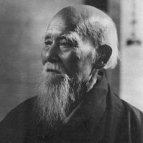Be
punctual: you should be changed and on the mats at least 10
minutes
before the start of class. Take this time to warm up. When the senior
student
sits down to form the lineup, other students should quickly form a
straight
line, From higher to lower rank from right to left.
If
you are late: Get changed and do your own warm ups OFF THE MATS.
When
you are ready, sit quietly on the edge of the mats, bow to O'Sensei,
and
then remain sitting until Sensei (or the senior instructor), gives you
permission to join the class.
If
you have to leave the mats during class: Ask
the Sensei (or senior student if they are teaching) for
permission.
Always
be alert while on the mats: Careless
practice can be dangerous and cause injury to yourself and others.
Keep
conversation to a minimum: During
practice there should be no discussion of anything other than Aikido
techniques.
Try to learn with your eyes and body, and help each other with the
appropriate
body movements rather than with words. If it is necessary to speak, do
so in a low voice.
Do
not teach fellow students: Unless specifically asked by the
Sensei.
Questions may be asked directly to the Sensei, or to one of the senior
students.
Hygiene
is very important: Personal hygiene is a reflection of your
respect
and attitude toward Aikido, the Sensei, your fellow practitioners, and
yourself. Keep your finger nails and toenails clean and short to
minimize
the chance of cutting yourself, other practitioners and mat surfaces.
Keep
your do-gi clean and wash it regularly.
Do
not wear jewelry during practice. Earings can be snagged on your
partner's
uniform and pulled off...ouch! Also do not wear make-up.
If
you become sick, overtired, or injured and cannot continue to practice:
let
your partner and the Sensei know before sitting off. If you just need a
short rest, bow to your partner and to the Sensei, move to the edge of
the mats and sit quietly watching the class until you are ready to
resume
practice.
Wear
thongs to and from the mats: This prevents dirt being tracked onto
the mats by bear feet or from street shoes
Page
updated Mar. 3, 2007 by Glenn Chapman





